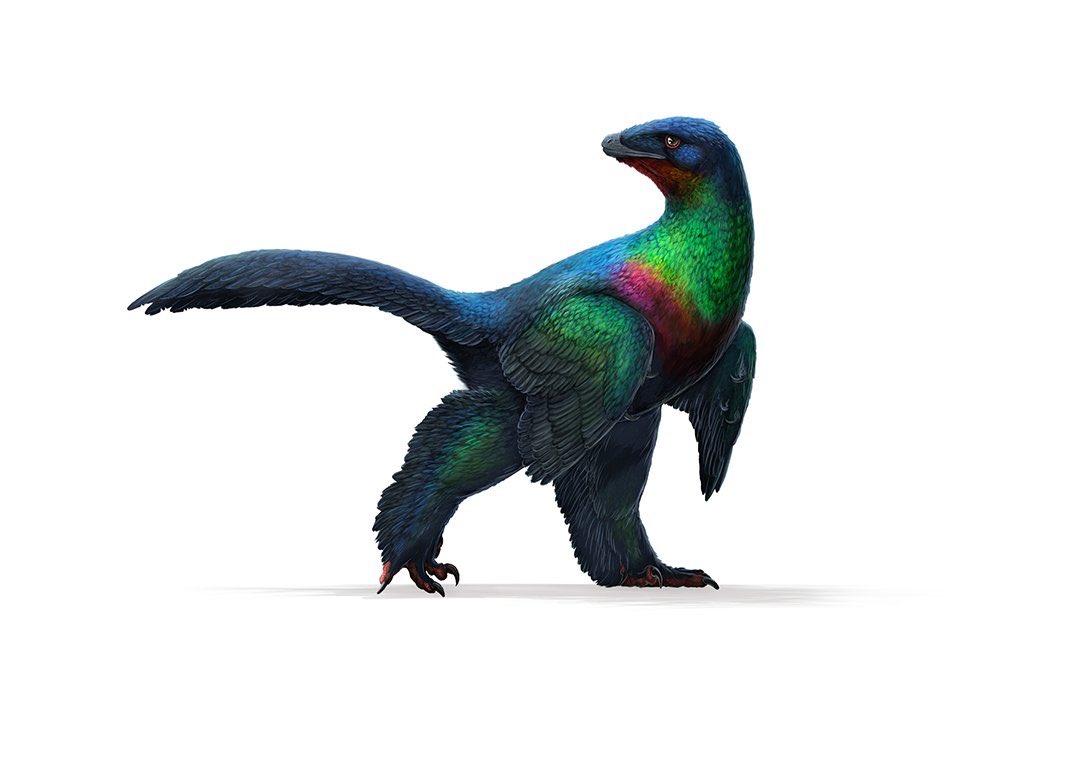A new species of dinosaur discovered in China has fur that can sparkle in rainbow colors. Based on the superbly preserved remains, scientists say the dinosaur’s head and chest appeared to be covered with iridescent feathers like those of modern hummingbirds.
Flashy displays may convey a social or sexual signal, like modern peacock tails. The dinosaur also had a bird-like body, including the feathers necessary for flight, but it had a crested head more similar to that of a Velociraptor .

For these characteristics, this ancient animal was named Caihong juji – Mandarin for “rainbow with large crest” – the team reports today in the journal Nature Communications .

Caihong lived in forests and could glide from tree to tree, preying on small mammals and lizards, said study co-author Xing Xu, a paleontologist at the Chinese Academy of Sciences. In life, a duck-sized predator would weigh about a pound.

“I was shocked by its beautifully preserved feathers, even though I had seen many feathered dinosaur fossils before,” Xu added.
Field Museum’s photo
Please respect copyright. Unauthorized use is prohibited.
Rainbow in the dark
Birds—the last living dinosaurs—today use feathers to fly, but feathers also help birds attract potential mates or jockeys to gain social status. Dinosaur fossils show that feathers first evolved for display, then later took on the features needed for flight. (Learn more about how feathers grow.)
Like modern and ancient birds, dinosaurs likely had color vision and took advantage of it to create impressive feathered displays. In special cases, scientists can reveal the original color of dinosaur feathers by finding traces of pigment sacs called melanosomes in fossil plumes. (See the full-body coloration of the feathered dinosaur Anchiornis .)
Yang Jan, a local farmer, found the Caihong fossil in northeastern China’s Hebei province. In February 2014, the Liaoning Museum of Paleontology acquired the fossil from January 1, 2014.
When scientists led by Dongyu Hu, a paleontologist at China’s Shenyang Normal University, examined the fossil, they discovered that its well-preserved remains contained traces of Pigment stains in its feathers. The team sampled 66 fossil sites, comparing the melanosomes they saw with melanosomes from modern bird feathers.
On Caihong ‘s head, thorax, and tail sections, researchers saw melanosomes that were long, flat, and organized into sheets. These patterns most closely resemble melanosomes in the iridescent throat feathers of hummingbirds.
In hummingbirds, similar structures divide light like a prism, creating a metallic sheen that changes color with viewing angle. The team couldn’t recreate the exact color of the dinosaur’s feathers, but they suspect that the pigments observed gave Caihong its rainbow glow.
Paleontologists have seen this sparkling phenomenon in dinosaurs before. In 2012, scientists found evidence that the feathered dinosaur Microraptor glowed blue in the sun like modern ravens and ravens. Unlike Caihong , however, Microraptor had iridescence all over—and it was much younger: Microraptor lived 40 million years after Caihong .
“When we put these data into the evolutionary tree, we realized two different ways to create iridescence in small carnivorous dinosaurs before the origin of birds. learn.
More than a light show
Paleontologist Steve Brusatte of the University of Edinburgh, who reviewed the study before publication, said Caihong may not have just used feathers to show off.
“Its fur is a brilliant rainbow of iridescent colors… but it doesn’t stop there,” he said. “It also has a funny bony crest protruding from the front of the eye, perhaps this is also a display structure.”
Field Museum’s photo
Please respect copyright. Unauthorized use is prohibited.
Additionally, Xu says that Caihong ‘s leaf-like tails are asymmetrically feathered and that their short, stiff leading edges would bear the aerodynamic loads of flight. The Caihong is currently the oldest known animal with this important adaptation. The iconic bird-like dinosaur Archeopteryx also had asymmetrical feathers, but it lived ten million years later.
For Caihong, “who knows what the use of this big and wide tail is?” said National Geographic Explorer Ryan Carney, a biologist at the University of South Florida who studies Archeopteryx . “Perhaps it was used as a dark background to create contrast with the metallic head during display?”
Clarke, an expert on the origins of birds, said that researchers are not yet sure how the Caihong uses its iridescent plumage, or whether males or females of the species have the plumage. different. So paleontologists can only hope for further study of new fossils and perhaps even more bones from Caihong and other feathered dinosaurs.
“The more feathered dinosaurs we find, the more we learn about how bird-like they were,” Brusatte added. “We have to treat these animals like birds. If we were alive at that time, that is [what] we would consider them to be.”





